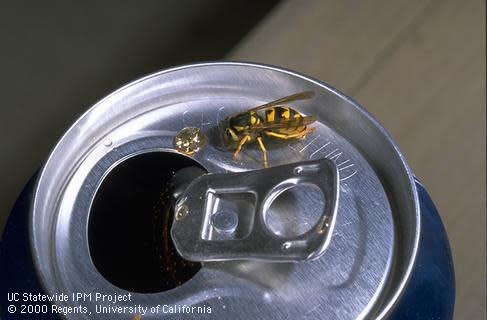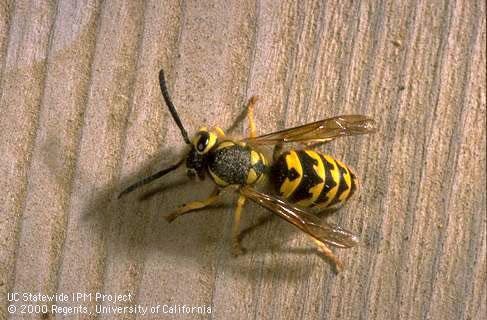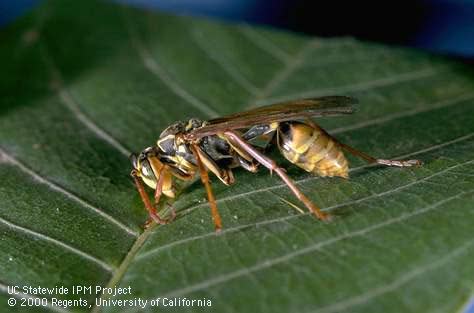Wasps: Here's what you should know about summer's uninvited barbecue guests
If you’ve had a barbecue outside, you have probably experienced yellow jackets foraging for food. They are primarily scavengers, and they start to show up at picnics and barbecues, around garbage cans, at dishes of dog or cat food placed outside, and where ripe or overripe fruit are accessible.
There are two types of social wasps in California, yellow jackets and paper wasps. Social wasps build nests and live in colonies. Yellow jackets are by far the most aggressive and troublesome group, especially ground and cavity-nesting ones such as the western yellow jacket, which tend to defend their nests vigorously when disturbed.

Yellow jacket and paper wasp queens begin their nests in spring when the weather becomes warm. From spring to midsummer larvae require large amounts of protein. Workers forage mainly for protein at this time — usually other insects — and for some sugars. By late summer the colonies grow more slowly and require large amounts of sugar to maintain the queen and workers; foraging wasps are particularly interested in sweet things at this time.
Yellow jackets
The most commonly encountered species is the western yellow jacket, sometimes referred to as the “meat bee.” These wasps are medium sized and black with jagged bands of bright yellow or white on the abdomen and have a very short, narrow waist where the thorax attaches to the abdomen.

Yellow jackets commonly build nests in rodent burrows but may also select voids in walls and ceilings of houses as nesting sites. Colonies can reach populations of between 1,500 and 15,000 individuals, depending on the species.
Their paper nests are made from fibers scraped from wood mixed with saliva. It is built as multiple tiers of vertical cells and enclosed by a paper envelope around the outside that usually contains a single entrance hole.
Paper Wasps
Paper wasps are 1-inch-long slender wasps with long legs and a distinct slender waist. Most Western species tend to be golden brown or darker with large patches of yellow or red.
They prefer to live in or near orchards or vineyards, they hang their paper nests in protected areas, such as under eaves, in attics, or under tree branches or vines. Each nest hangs like an open umbrella and has open cells that can be seen from beneath the nest. Sometimes white, grub-like larvae can be seen from below.

Wasps are a beneficial insect, they are great at pollinating and eliminate large numbers of other pest insects through predation and should be encouraged to nest in areas of little human or animal activity.
Management
The best way to prevent unpleasant encounters with social wasps is to avoid them. If you know where they are, try not to go near their nesting places. Wasps can become very defensive when their nest is disturbed.
Discouraging or eliminating nests
Early in the season, simply knocking down newly started paper wasp nests will cause the founding female to go elsewhere to start again.
Trapping wasps
Trapping is one method that can be employed to try to reduce yellow jacket problems. Trapping is not suggested for other social wasp species.
Lure traps
The easiest traps to use are lure traps, available for purchase at many garden retail stores. Lure traps can help reduce the number of localized foraging workers, but they do not eliminate large populations. Lure traps contain heptyl butyrate that attracts western yellow jackets into the traps, but not other species. It is important to place traps along the edge of the property line as far away from the patio or other protected area as possible. Lures need to be replaced periodically; follow trap directions regarding replacement.
Water traps
Water traps generally are homemade and consist of a 5-gallon bucket, string, and protein bait such as turkey, ham or fish. Fill the bucket with soapy water and suspend the bait 1 to 2 inches above the water. The yellow jacket flies down and becomes trapped in the water and drowns.
Nest sprays
Aerosol sprays labeled for use on wasp and hornet nests are effective against yellow jackets and paper wasps, but the products must be used with extreme caution. Wasps will attack if they sense a poison being applied to their nests. The best time to spray is at night when the wasps are the most likely to be in the nest.
For gardening-related questions, call the UC Master Gardener office at (209) 953-6112, or visit our website at ucanr.edu/sjmg. Information for this article came from the UC IPM website.
This article originally appeared on The Record: Gardening tips: Here's what you should know about wasps
